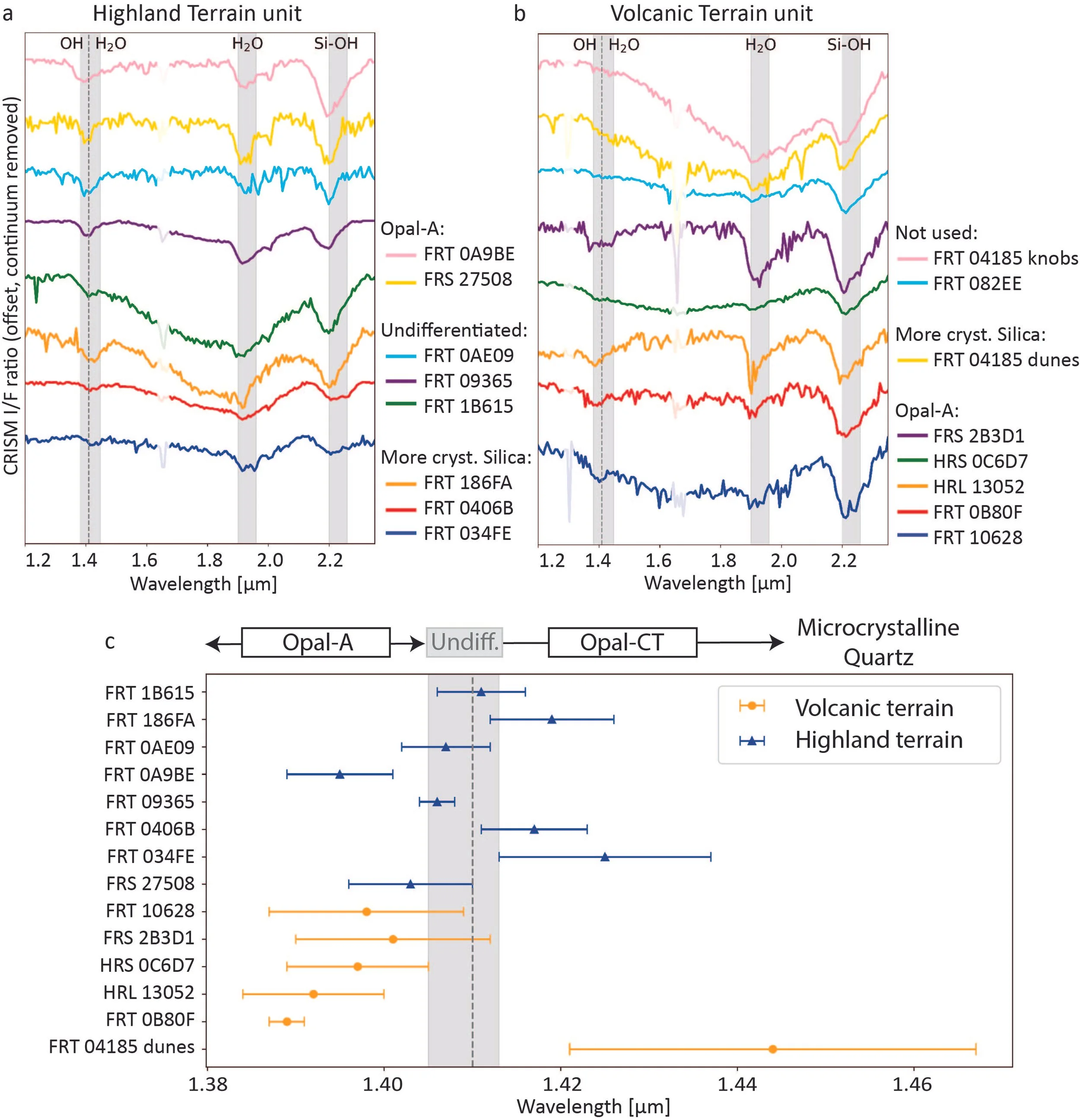
Aqueous Processes, Water–Rock Interaction, and Habitability
While Mars’s surface is dominated by volcanic terrains, the surface and subsurface have experienced aqueous modification and are thus often shaped by an interplay between volcanic and aqueous activities, allowing to form habitable environments.
Hydrated Silica, Mars
The presence of hydrated silica indicates water–rock interactions during the time of formation and thus can be used as an indicator for certain environment conditions. In addition to implications on aqueous conditions, siliceous materials—including opal—provide an excellent substrate to preserve biosignatures in the geologic record and thus represent prime targets for future astrobiological explorations (Voigt et al., 2024). Syrtis Major is volcanic complex that experienced both effusive and explosive eruptions and is the the place on Mars with one of the first and most prominent detections of hydrated silica from orbital infrared spectra (CRISM), indicating hydrothermal activity within the last stage of the volcanic activity (Voigt et al., 2024). We used the opal crystalline to identify the extent and longevity of water–rock interaction in Sytris Major.
To gain a better understanding of the availability and longevity of water on Mars’s surface, we further investigate hydrated silica on a global scale thereby marking location of short-lived and long-lived water-rock interaction (Voigt et al., in prep.).
Aqueous Activities in Elysium Planitia, Mars
Elysium Planitia is home to the largest outflow channel carved in the Amazonian epoch, Marte Vallis (Voigt et al., 2018). Volcanic rootless cones within three major flood basalts in Elysium Planitia suggest that lava interacted with a volatile-bearing substrate during the time of eruption, possibly forming habitable hydrothermal environments. However, to date, ground ice/volatile-bearing sediments within Elysium Planitia is likely restricted to local patches and not infilling the large valley systems such as Marte Vallis or Athabasca Valles (Voigt et al., 2023).
Aqueous Alteration History in the Libya Montes Region, Mars
The Libya Montes region on Mars shows evidence of both ancient and long-lasting fluvial activity and chemical alteration. The area contains Noachian to Amazonian aged rocks with olivine and pyroxene-rich outcrops. It also features various Fe/Mg-smectite and Al-smectite mineral deposits, formed likely due to hydrothermal activity from the Isidis Basin impact and subsequent fluvial processes (Bishop et al., 2013). We combined geologic mapping with spectral analysis to explore the mineralogy and geologic history, indicating extensive aqueous alteration of ancient basaltic crust followed by lava emplacement.
At Hashir and Bradbury impact craters, we identified multiple units formed through volcanic, impact, hydrothermal, lacustrine, and evaporative processes. The findings reveal diverse mineral assemblages, indicating varied aqueous alteration processes, transitioning from Noachian hydrothermal activity to Hesperian volcanic and lacustrine environments, followed by Amazonian resurfacing through aeolian erosion (Tirsch et al., 2018).
Relevant Publications
Investigating Hydrated Silica in Syrtis Major, Mars: Implications for the Longevity of Water–Rock Interaction
J. R. C. Voigt, V. Z. Sun, C. E. Viviano, and K. M. Stack (2024)
Geophysical Research Letters
Geology of central Libya Montes, Mars: Aqueous alteration history from mineralogical and morphological mapping
D. Tirsch, G. Erkeling, J. Bishop, J. R. C. Voigt, L. Tornabene, and R. Jaumann (2018)
Icarus
Investigating the Volcanic versus Aqueous Origin of the Surficial Deposits in Eastern Elysium Planitia, Mars
J. R. C. Voigt, and C. W. Hamilton (2018)
Icarus
Mineralogy and morphology of geologic units at Libya Montes, Mars: Ancient aqueously derived outcrops, mafic flows, fluvial features, and impacts
J. L. Bishop, D. Tirsch, L. L. Tornabene, R. Jaumann, A. S. McEwen, P. C. McGuire, A. Ody, F. Poulet, R. N. Clark, M. Parente, N. K. McKeown, J. F. Mustard, S. L. Murchie, J. Voigt, Z. Aydin, M. Bamberg, A. Petau, G. Michael, F. P. Seelos, C. D. Hash, G. A. Swayze, and G. Neukum (2013)
Journal of Geophysical Research: Planets
Revealing Elysium Planitia's Young Geologic History: Constraints on Lava Emplacement Styles, Areas, and Volumes
J. R. C. Voigt, C. W. Hamilton, G. Steinbrügge, M. Christoffersen, S. Nerozzi, L. Kerber, J. Holt, and L. M. Carter (2023)
Journal of Geophysical Research: Planets







